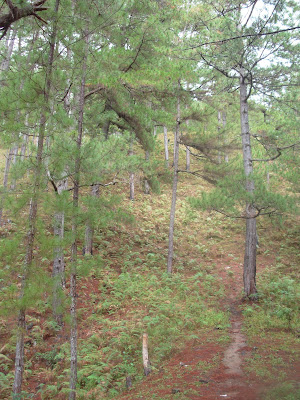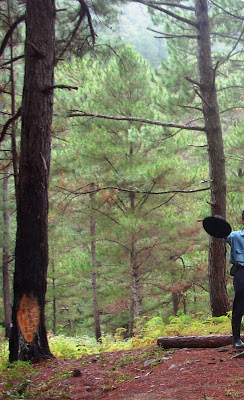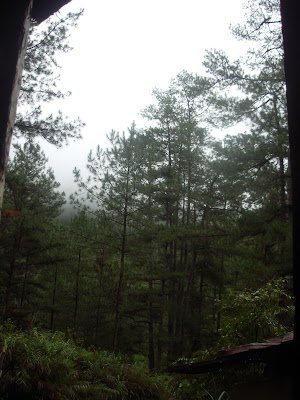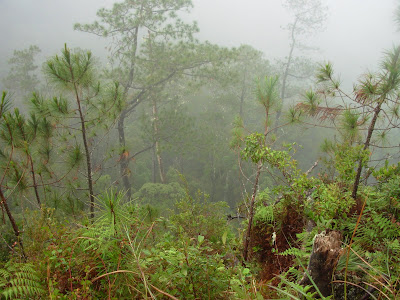Nowra, a bustling commercial centre on the Shoalhaven River, is a major town on the New South Wales south coast and is close to the natural and cultural features of the Shoalhaven and Southern Highlands districts.
After refueling in Bomaderry and then some lunch in Nowra, we leave the princes highway and take the less travelled Moss Vale Road turnoff towards kangaroo valley. A few kms out on the winding ascent to a mountain range, we saw a signpost and followed the tourist road to the wonders of Cambewarra Mountain Lookout.
Perched about 600m high on the summit of the Cambewarra Range, 'The Lookout' commands a magnificent panorama of Shoalhaven and beyond to some National Park. Aside from the breathtaking views and the natural beauty, there are some wonderful wildlife inhabiting the area but which we didn’t have time to see, so we descended back to the main road to Kangaroo Valley.
This road is similar to the zigzag stretch of kennon road between camp 7 and camp 6 in benguet, or Antadao and Dantay in Mountain Province. Kangaroo Valley is described as "The most beautiful valley in Australia". Obviously the describers haven’t seen kalabaw valley in the Philippines, where the kalabaw roam. This valley has a variety of native flora and fauna, rich green pastures, sparkling creeks and rivers and lush rainforests, and enclosed by natural escarpments. And just like Samoki valley and Bontoc town, there’s also no traffic lights here.
The first recorded European sighting of the valley was in April 1812, when the explorer George Evans passed through the area and reportedly claimed that the valley offered a view that "no painter could beautify."
(Well the first recorded Imainit sighting of this part of the world is 3 years prior to April 2012 when M Polichay passed through and reported on his blog that ‘no beauty could paint’ the yet undiscovered kalabaw valley. )
Between kangaroo valley and the lower outskirts of the southern highlands, is Fitzroy Falls which we visited years ago, before the time of the blogosaurs smstxtiles and cellfonosaurus. We yelled out hello on the way past. We could well have beeped but we were polite that day.
Southern Highlands.
The Southern Highlands is a collective name of the many towns and villages of the Wingecarribee Region of New South Wales, Australia. Just like the northern uplands of the Philippines where applai is the collective name for the people and the towns and villages of western mountain province. Maybe I should 'apply' to a girl from there.
The Southern Highlands is the perfect escape to get away from the hustle and bustle of city life. We visited here a few times before. Last time we visited here we stayed in Bowral and also visited Exeter. We also had a picnic at wingecarribee dam and drove down to fitzroy falls.
Over a million visitors each year come to enjoy the lifestyle, the serene and tranquil atmosphere and peaceful seclusion. From the breath-taking scenery of the quaint countryside with its rolling hills of vineyards, one finds plenty to see and do, with many an antique art and craft and book stores, classy restaurants and cafes, weekend markets, open gardens, rain forests and national parks, or just having a family picnic. For the young and old, the Southern Highlands is a charming experience.
On Easter Saturday we drove around the various vineyards but they were all closed that day. Next time I will definitely visit them for some wine tasting.
A couple of the towns we visited here are Berrima and Mittagong.
Berrima is a living example of an early colonial town with architecture dating back to the 1830's. It was built around the concept of an "English Village Common". Here you will find many businesses housed in superb colonial architecture.
 |
| Inn in Berrima |
In Berrima we visited an oldish inn and old bakehouse.
 |
| Old Bakery cottage, Berrima |
The hearth of the Old bakery on one wall of the dining area of the cafe where we tried out the local fare. bellissimo!
Mittagong is the gateway to the Southern Highlands from Sydney. Mittagong was formerly on the Hume Highway, which links Sydney, Canberra and Melbourne, but the highway was diverted in 1992.
 |
| An old building in Mittagong is the grand hotel. |
Sydney.
After a couple of days in the southern highlands we travelled back to home base in Sydney on the old hume highway. Sydney is like an old friend that you look forward to seeing now and then.
The old features of old Sydney town are still worth seeing.
 |
| Hyde Park |
Hyde park viewed from centrepoint tower looks like an oasis in a desert not of sand dunes but of modern buildings.
 |
| Postbox at the centrepoint tower |
And while on the centrepoint tower we took the chance to post a couple of postcards from the highest working post box in the southern hemisphere. It is also a most expensive place to enter.
After hitching a ride on the Oz trek adventure ride, we then descended into circular quay.
 |
| Circular Quay, Sydney |
At the quay we renewed acquaintances with the best-known coathanger in the world aka the Sydney harbor bridge, and the biggest seashell building in the world aka sydney opera house.
 |
| the coathanger 'Sydney harbor bridge' |
The biggest seashell building in the world is called the o’pera house. Whoever built it must have had a lot of
pera to need to house them
he he.A bit lame but… must be the wobbles from the cost of coffee at starbucks. The coffee didn’t even have whiskey.
 |
| Sydney Opera House |
Easter time was a little quiet in Sydney. We even drove around Sydney harbour to the inner northern suburbs, and then from lane cove back across the harbour to the inner southern suburbs via drummoyne. In the evening we visited the fish market in pyrmont for some fresh seafood for dinner.
watch a youtube video of this trip:
for a slightly shorter version click below:
Includes song clips from ms e harris and messrs l lovett, n young, p seeger, r mcguinn, k friedman, & k kristofferson.

.jpg) uphill.
uphill..jpg) and downhill. and uphill and downhill. and uphill and downhill. oh you get to do this a few times.
and downhill. and uphill and downhill. and uphill and downhill. oh you get to do this a few times..jpg)
.jpg) or looking after their precious few heads of cattle.
or looking after their precious few heads of cattle. .jpg) or looking after their precious few heads of cattle.
or looking after their precious few heads of cattle. .jpg) stop and chat to a forest ranger when you meet him. he is only a volunteer and does not get paid to protect the mountains.
stop and chat to a forest ranger when you meet him. he is only a volunteer and does not get paid to protect the mountains..jpg) a tipple or two would not hurt, and he might tell you a tale or two in return.
a tipple or two would not hurt, and he might tell you a tale or two in return..jpg) but deep into the mountains, with civilization out of reach, you finally find yourself lost in another planet.
but deep into the mountains, with civilization out of reach, you finally find yourself lost in another planet..jpg)
.jpg) so tread carefully.
so tread carefully..jpg) my cousin sent me these photos last january 2008. this is near the epicentre of the earthquake that was felt in abra, the ilocos and other surrounding areas, even as far as baguio 150kms away.
my cousin sent me these photos last january 2008. this is near the epicentre of the earthquake that was felt in abra, the ilocos and other surrounding areas, even as far as baguio 150kms away..jpg)
.jpg)
.jpg) the mountains are the window to the future. protect them and they will protect us. lobby your officials. talk to your representatives about preserving the cordillera mountains. our survival and yours, may depend on them.
the mountains are the window to the future. protect them and they will protect us. lobby your officials. talk to your representatives about preserving the cordillera mountains. our survival and yours, may depend on them. .jpg)
.jpg)
.jpg)
.jpg)
.jpg)
.jpg)



